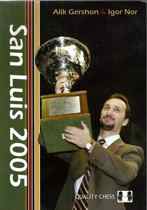San Luis 2005
Alik Gershon, Igor Nor

Books about chess tournaments used to be a dime a dozen, but the creation of databases made all but the best of them useless and the whole genre has slowly but surely faded away. Now Quality Chess (a publishing company thats responsible for some stupendous books) has brought us San Luis 2005 and reminded us that a tournament book can still be a pleasure to read.
Personally, when I read a tournament book I try to relive the drama of the fight for first place. I push out my memories of what happened and follow the action round by round as if it was occurring live before me. A really good tournament book is able to incite ones sense of excitement at the battle for first place, and to offer us a window into the players thoughts and artistic talents via the notes to the games. And, when the comments, notes, and games have been digested, the reader is left with a sense of awe at the winners achievement and at the efforts of the other players who tried (but ultimately failed) to stand in his way.
San Luis 2005 succeeds in accomplishing most of the above by starting out with a foreword by Topalov, another (highly thought provoking!) foreword by Short, and a preface by Marin. An introduction follows which talks about the event in general, then gives bios (with color photos) of all the players, and then shows us how all the participants have fared against each other in the past, not only giving their individual scores but also telling us how their styles mesh. An amazing beginning (taking over 40 pages), and we havent even seen round one yet!
Each round starts with the results, the standings, and with a lead-in to the mood and general feel of the event up to that point. And then come the games, each and every one given extremely dense annotations (the four games in the first round demanded 24 pages to bare their secrets to the reader).
When the games are exhausted (on page 431), we are given an afterword, a final crosstable, a 7-page article titled “Chess in the New Millennium or Binary Conspiracies that discusses illegal computer use in tournaments, a games Index, and an openings index. When you also take into account that the book is full of color photos of all aspects of the tournament, one can fully understand why many reviewers have labeled San Luis 2005 the “tournament book of the decade. In fact, there isnt any doubt at all that this is indeed the best (by far) tournament book of the last few decades. Small wonder then that San Luis 2005 won the prestigious English Chess Federation Book of the Year Award.
But, though Ive praised the book to the heavens, I also have one (very personal) caveat: Though the design is nice, and photos well received, the many wonderful touches mentioned above beyond the call of duty, and the games fascinating and magnificently annotated, the authors notes failed to convey the warmth, humor, and whimsy that writers like Tal and Larsen and Tartakower, and even George Marco magically coax from their pens. There is no shame in this since such a talent is extremely rare. But when comparing San Luis 2005 with other legendary tournament books (and Ive heard quite a few players claiming it to be the greatest tournament book of all time), I think this needs to be addressed.
Lets take Zurich 1953 as an example. San Luis 2005 trumps this classic in every way except one: I find the games and the notes in Zurich 1953 to be more instructive for players under 2000. Please note the difference between “instructive and better”.
Another example is Karlsbad 1907. This 450-page hardcover (Caissa Editions) is fantastic, but it again doesnt completely measure up to the standard that San Luis 2005 set. However, George Marcos notes are so enjoyable on so many levels that it makes the other factors unimportant: I would much prefer to have Karlsbad 1907 on a 1-year journey to Mars than San Luis 2005.
Naturally, the reader needs to decide what kind of writing he enjoys, and if such highly personal things as “charm and instruction and whimsy and warmth” are really needed in a tournament book. And dont forget that whats charming to one man might prove uninteresting to another.
To sum up, if you are into tournament books, then this is a must buy. San Luis 2005 might well be the finest tournament book of all time. For overall content and technical excellence, its clearly in a class by itself.
